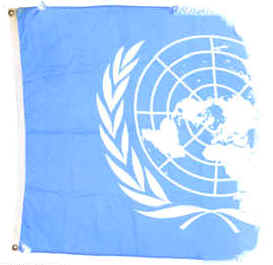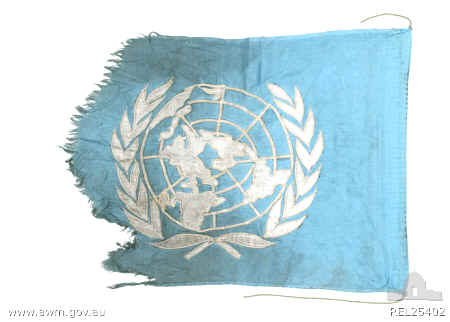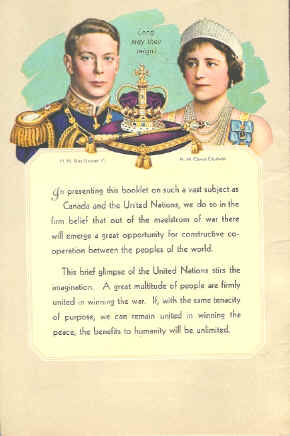 |
| Category: Flags |

|
|
|
|
|
|
United Nations Flags with an
Aussie accent. |
 |
Blue nylon United Nations
flag flown over UN headquarters in Jerusalem at the start of the Six Day
War between Israel and Jordan on 6 June 1967.
Major Colin Frederick John
('Col') Woodland, who was serving with the United Nations Truce
Supervision Organisation (UNTSO) later collected the flag, which was
signed by those present.
Col Woodland was born at Peking, China, in 1922,
son of Australian Salvationist missionary parents. |
| He was raised and
educated in China, mostly at the English-speaking Tientsin Grammar School,
although he and his family visited Australia several times on leave.
In 1940, completing his education in Shanghai, Woodland obtained a
position with a local import-export firm, and also joined the Shanghai
Volunteer Corps, a citizen's military unit. He later became part of
the Shanghai Scottish company, and helped to guard the perimeter of the
International Settlement against Japanese incursion. Owing to his
father's deteriorating health, Woodland and his family left China in
November 1941, and returned to Australia, narrowly avoiding the Japanese
attacks on Hong Kong, Singapore and Jakarta en route. While in Singapore,
he attempted to join a British regiment, but decided to follow his
father's advice and return to Australia before enlisting. In
February 1942, he was accepted for service in the AIF, becoming QX29957
with 7 Pioneer Company, and in February 1943 he was posted to New Guinea
as a reinforcement to 2/7 Infantry Battalion, joining the unit at Wau.
During the following months, Woodland saw service at Wau, Mubo and
Salamaua, but he was evacuated late in the year suffering from sciatica.
A further series of injuries rendered him unfit for active service, and he
was discharged in mid 1944, joining the Commonwealth Public Service. In
1952 he enlisted in the CMF, and in 1957 he was commissioned as a second
lieutenant with 3 Infantry Battalion. In 1966, he applied to become
an officer with UNTSO in Palestine, and was transferred to the regular
army with the rank of Major. The posting to UNTSO took Woodland and
his family to Jerusalem, but the deteriorating situation and increasing
hostility between Israel and Jordan led to the evacuation of families in
May 1967. On 6 June 1967, the Six Day War broke out, and the Mixed
Armistice Commission (MAC) headquarters of UNTSO in Jerusalem were at the
centre of serious fighting as Israeli forces defeated the Jordanian Army.
Woodland remained on duty with other observers throughout the fighting,
and oversaw the signing of the ceasefire on the Damascus road some days
later. In 1969, he returned to Australia and, on discharge from the
regular army, rejoined the CMF. He later became part of the
Department of Foreign Affairs' Aid Branch, and worked in Vietnam and the
south west Pacific before retiring from the public service in 1974.
Col Woodland died in Queensland in 1997. AWM 32510 |
 |
This flag was collected by
326853 Lieutenant Colonel (then Major) Dean Herbert of the Australian
Army, while serving as a United Nations Military Observer (UNMO) with the
United Nations Truce Supervisory Organisation (UNTSO) in 1997. UNTSO,
which monitors activity in the strategically important Golan Heights on
the Israeli-Syrian border, was the first Peacekeeping operation undertaken
by the UN, in 1948, and remains in place today. The flag, which had flown
over Observation Post 71, was souvenired by Major Herbert after it was
withdrawn from use, being worn out by the extremes of climate in the
region. AWM 31738 |
| United Nations flag :
UNMCTT (United Nations Mine Clearance Training Team) Afghanistan
&/or Pakistan c.1990s |
 |
|
Images from CWO H H "Sarge"
Booker II
|
| The name
"United Nations", coined by United States President Franklin
D. Roosevelt, was first used in the "Declaration by United
Nations" of 1 January 1942, during the Second World War, when
representatives of 26 nations pledged their Governments to continue
fighting together against the Axis Powers.
States first established international
organizations to cooperate on specific matters. The International
Telecommunication Union was founded in 1865 as the International
Telegraph Union, and the Universal Postal Union was established in 1874.
Both are now United Nations specialized agencies.
|
|
|
 |
 |
| In 1899, the International Peace
Conference was held in The Hague to elaborate instruments for settling
crises peacefully, preventing wars and codifying rules of warfare. It
adopted the Convention for the Pacific Settlement of International
Disputes and established the Permanent Court of Arbitration, which began
work in 1902.
The
forerunner of the United Nations was the League
of Nations, an organization
conceived in similar circumstances during the first World War, and
established in 1919 under the Treaty of Versailles "to promote
international cooperation and to achieve peace and security." The
International Labour Organization was also created under the Treaty of
Versailles as an affiliated agency of the League. The League of Nations
ceased its activities after failing to prevent the Second World War.
In 1945, representatives of 50
countries met in San Francisco at the United Nations Conference on
International Organization to draw up the United Nations Charter. Those
delegates deliberated on the basis of proposals worked out by the
representatives of China, the Soviet Union, the United Kingdom and the
United States at Dumbarton Oaks, United States in August-October 1944.
The Charter was signed on 26 June 1945 by the representatives of the 50
countries. Poland, which was not represented at the Conference, signed
it later and became one of the original 51 Member States.
The United Nations officially came
into existence on 24 October 1945, when the Charter had been ratified by
China, France, the Soviet Union, the United Kingdom, the United States
and by a majority of other signatories. United Nations Day is celebrated
on 24 October each year. Extracted from: Basic
Facts About the United Nations 2000. |
|